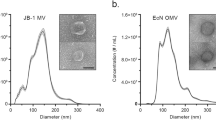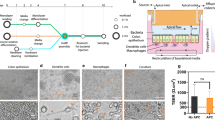Abstract
The specialized microfold cells (M cells) in the follicle-associated epithelium (FAE) of intestinal Peyer's patches serve as antigen-sampling cells of the intestinal innate immune system. Unlike 'classical' enterocytes, they are able to translocate diverse particulates without digesting them. They act as pathways for microorganism invasion and mediate food tolerance by transcellular transport of intestinal microbiota and antigens. Their ability to transcytose intact particles can be used to develop oral drug delivery and oral immunization strategies. This protocol describes a reproducible and versatile human M-cell-like in vitro model. This model can be exploited to evaluate M-cell transport of microparticles and nanoparticles for protein, drug or vaccine delivery and to study bacterial adherence and translocation across M cells. The inverted in vitro M-cell model consists of three main steps. First, Caco-2 cells are seeded at the apical side of the inserts. Second, the inserts are inverted and B lymphocytes are seeded at the basolateral side of the inserts. Third, the conversion to M cells is assessed. Although various M-cell culture systems exist, this model provides several advantages over the rest: (i) it is based on coculture with well-established differentiated human cell lines; (ii) it is reproducible under the conditions described herein; (iii) it can be easily mastered; and (iv) it does not require the isolation of primary cells or the use of animals. The protocol requires skills in cell culture and microscopy analysis. The model is obtained after 3 weeks, and transport experiments across the differentiated model can be carried out over periods of up to 10 h.
This is a preview of subscription content, access via your institution
Access options
Access Nature and 54 other Nature Portfolio journals
Get Nature+, our best-value online-access subscription
$29.99 / 30 days
cancel any time
Subscribe to this journal
Receive 12 print issues and online access
$259.00 per year
only $21.58 per issue
Buy this article
- Purchase on Springer Link
- Instant access to full article PDF
Prices may be subject to local taxes which are calculated during checkout




Similar content being viewed by others
References
Hubatsch, I., Ragnarsson, E.G. & Artursson, P. Determination of drug permeability and prediction of drug absorption in Caco-2 monolayers. Nat. Protoc. 2, 2111–2119 (2007).
des Rieux, A., Fievez, V., Garinot, M., Schneider, Y.J. & Préat, V. Nanoparticles as potential oral delivery systems of proteins and vaccines: a mechanistic approach. J. Control. Release 116, 1–27 (2006).
Brayden, D.J., Jepson, M.A. & Baird, A.W. Keynote review: intestinal Peyer′s patch M cells and oral vaccine targeting. Drug Discov. Today 10, 1145–1157 (2005).
Brayden, D.J. & Baird, A.W. Microparticle vaccine approaches to stimulate mucosal immunisation. Microbes Infect. 3, 867–876 (2001).
Kerneis, S., Bogdanova, A., Kraehenbuhl, J.P. & Pringault, E. Conversion by Peyer's patch lymphocytes of human enterocytes into M cells that transport bacteria. Science 277, 949–952 (1997).
Gullberg, E. et al. Expression of specific markers and particle transport in a new human intestinal M-cell model. Biochem. Biophys. Res. Commun. 279, 808–813 (2000).
Kimura, S., Kishimoto, A., Mutoh, M., Takahashi-Iwanaga, H. & Iwanaga, T. GP2-expressing cells in the conjunctiva and tear ducts of mice: identification of a novel type of cells in the squamous stratified epithelium. Biomed. Res. 36, 263–272 (2015).
Miyake, M., Ragnarsson, E., Nakai, D. & Artursson, P. The pro-inflammatory cytokine interleukin-6 regulates nanoparticle transport across model follicle-associated epithelium cells. J. Pharm. Sci. 105, 2099–2104 (2016).
des Rieux, A. et al. Transport of nanoparticles across an in vitro model of the human intestinal follicle associated epithelium. Eur. J. Pharm. Sci. 25, 455–465 (2005).
des Rieux, A. et al. An improved in vitro model of human intestinal follicle-associated epithelium to study nanoparticle transport by M cells. Eur. J. Pharm. Sci. 30, 380–391 (2007).
Ohno, H. Intestinal M cells. J. Biochem. 159, 151–160 (2016).
des Rieux, A., Pourcelle, V., Cani, P.D., Marchand-Brynaert, J. & Préat, V. Targeted nanoparticles with novel non-peptidic ligands for oral delivery. Adv. Drug Deliv. Rev. 65, 833–844 (2013).
Gullberg, E. et al. Identification of cell adhesion molecules in the human follicle-associated epithelium that improve nanoparticle uptake into the Peyer′s patches. J. Pharmacol. Exp. Ther. 319, 632–639 (2006).
Lo, D. et al. Cell culture modeling of specialized tissue: identification of genes expressed specifically by follicle-associated epithelium of Peyer's patch by expression profiling of Caco-2/Raji co-cultures. Int. Immunol. 16, 91–99 (2004).
Araujo, F. et al. In vitro M-like cells genesis through a tissue-engineered triple-culture intestinal model. J. Biomed. Mater. Res. B Appl. Biomater. 104, 782–788 (2015).
Schimpel, C. et al. Development of an advanced intestinal in vitro triple culture permeability model to study transport of nanoparticles. Mol. Pharm. 11, 808–818 (2014).
Gonzalez-Hernandez, M.B. et al. Murine norovirus transcytosis across an in vitro polarized murine intestinal epithelial monolayer is mediated by M-like cells. J. Virol. 87, 12685–12693 (2013).
Miyazawa, K. et al. Transcytosis of murine-adapted bovine spongiform encephalopathy agents in an in vitro bovine M cell model. J. Virol. 84, 12285–12291 (2010).
Banerjee, A., Qi, J., Gogoi, R., Wong, J. & Mitragotri, S. Role of nanoparticle size, shape and surface chemistry in oral drug delivery. J. Control. Release 238, 176–185 (2016).
Ragnarsson, E.G. et al. Yersinia pseudotuberculosis induces transcytosis of nanoparticles across human intestinal villus epithelium via invasin-dependent macropinocytosis. Lab Invest. 88, 1215–1226 (2008).
des Rieux, A. et al. Helodermin-loaded nanoparticles: characterization and transport across an in vitro model of the follicle-associated epithelium. J. Control. Release 118, 294–302 (2007).
Slutter, B. et al. Mechanistic study of the adjuvant effect of biodegradable nanoparticles in mucosal vaccination. J. Control. Release 138, 113–121 (2009).
Garinot, M. et al. PEGylated PLGA-based nanoparticles targeting M cells for oral vaccination. J. Control. Release 120, 195–204 (2007).
Fievez, V. et al. In vitro identification of targeting ligands of human M cells by phage display. Int. J. Pharm. 394, 35–42 (2010).
Finn, R. et al. Translocation of Vibrio parahaemolyticus across an in vitro M cell model. FEMS Microbiol. Lett. 350, 65–71 (2014).
Curzer, H.J., Perry, G., Wallace, M.C. & Perry, D. The three Rs of animal research: what they mean for the institutional animal care and use committee and why. Sci. Eng. Ethics 22, 549–565 (2016).
de Lau, W. et al. Peyer's patch M cells derived from Lgr5(+) stem cells require SpiB and are induced by RankL in cultured ‘miniguts’. Mol. Cell Biol. 32, 3639–3647 (2012).
Wood, M.B., Rios, D. & Williams, I.R. TNF-α augments RANKL-dependent intestinal M cell differentiation in enteroid cultures. Am. J. Physiol. Cell Physiol. 311, C498–507 (2016).
Coco, R. et al. Drug delivery to inflamed colon by nanoparticles: comparison of different strategies. Int. J. Pharm. 440, 3–12 (2013).
Velin, A.K., Ericson, A.C., Braaf, Y., Wallon, C. & Söderholm, J.D. Increased antigen and bacterial uptake in follicle associated epithelium induced by chronic psychological stress in rats. Gut 53, 494–500 (2004).
Beloqui, A., des Rieux, A. & Préat, V. Mechanisms of transport of polymeric and lipidic nanoparticles across the intestinal barrier. Adv. Drug Deliv. Rev. 106, 242–255 (2016).
Siissalo, S. et al. Effect of cell differentiation and passage number on the expression of efflux proteins in wild type and vinblastine-induced Caco-2 cell lines. Eur. J. Pharm. Biopharm. 67, 548–554 (2007).
Makino, K. et al. Genome sequence of Vibrio parahaemolyticus: a pathogenic mechanism distinct from that of V. cholerae. Lancet 361, 743–749 (2003).
Cedervall, T. et al. Understanding the nanoparticle-protein corona using methods to quantify exchange rates and affinities of proteins for nanoparticles. Proc. Natl. Acad. Sci. USA 104, 2050–2055 (2007).
de Both, N.J., Vermey, M., Dinjens, W.N. & Bosman, F.T. A comparative evaluation of various invasion assays testing colon carcinoma cell lines. Br. J. Cancer 81, 934–941 (1999).
Beloqui, A. et al. Mechanism of transport of saquinavir-loaded nanostructured lipid carriers across the intestinal barrier. J. Control. Release 166, 115–123 (2013).
Artursson, P., Palm, K. & Luthman, K. Caco-2 monolayers in experimental and theoretical predictions of drug transport. Adv. Drug Deliv. Rev. 46, 27–43 (2001).
Carradori, D., Barreau, K. & Eyer, J. The carbocyanine dye DiD labels in vitro and in vivo neural stem cells of the subventricular zone as well as myelinated structures following in vivo injection in the lateral ventricle. J. Neurosci. Res. 94, 139–148 (2016).
Clark, L., Martinez-Argudo, I., Humphrey, T.J. & Jepson, M.A. GFP plasmid-induced defects in Salmonella invasion depend on plasmid architecture, not protein expression. Microbiology 155, 461–467 (2009).
Acknowledgements
A.B. is a postdoctoral researcher from the Belgian Fonds National de la Recherche Scientifique (FRS–FNRS), Belgium. A.d.R. is a research associate of the FRS–FNRS, Belgium. We thank T. Ahmad for assistance with interpreting the microbiology studies at University College Dublin. The research leading to some of these results received funding from the European Union Seventh Framework Programme (FP7) from 2007 through 2013 under grant agreement no. 281035.
Author information
Authors and Affiliations
Contributions
A.B. and A.d.R. wrote the draft protocol, excluding the discussion of data for the transport of bacteria. D.J.B. wrote the discussions of experimental data related to the transport of bacteria and viruses across M cells, including Box 4, and edited the English language. All authors contributed to the composition, correction and editing of the protocol and have jointly supervised the work.
Corresponding author
Ethics declarations
Competing interests
The authors declare no competing financial interests.
Supplementary information
Rights and permissions
About this article
Cite this article
Beloqui, A., Brayden, D., Artursson, P. et al. A human intestinal M-cell-like model for investigating particle, antigen and microorganism translocation. Nat Protoc 12, 1387–1399 (2017). https://doi.org/10.1038/nprot.2017.041
Published:
Issue Date:
DOI: https://doi.org/10.1038/nprot.2017.041
This article is cited by
-
Development of an M cell targeted nanocomposite system for effective oral protein delivery: preparation, in vitro and in vivo characterization
Journal of Nanobiotechnology (2021)
Comments
By submitting a comment you agree to abide by our Terms and Community Guidelines. If you find something abusive or that does not comply with our terms or guidelines please flag it as inappropriate.



